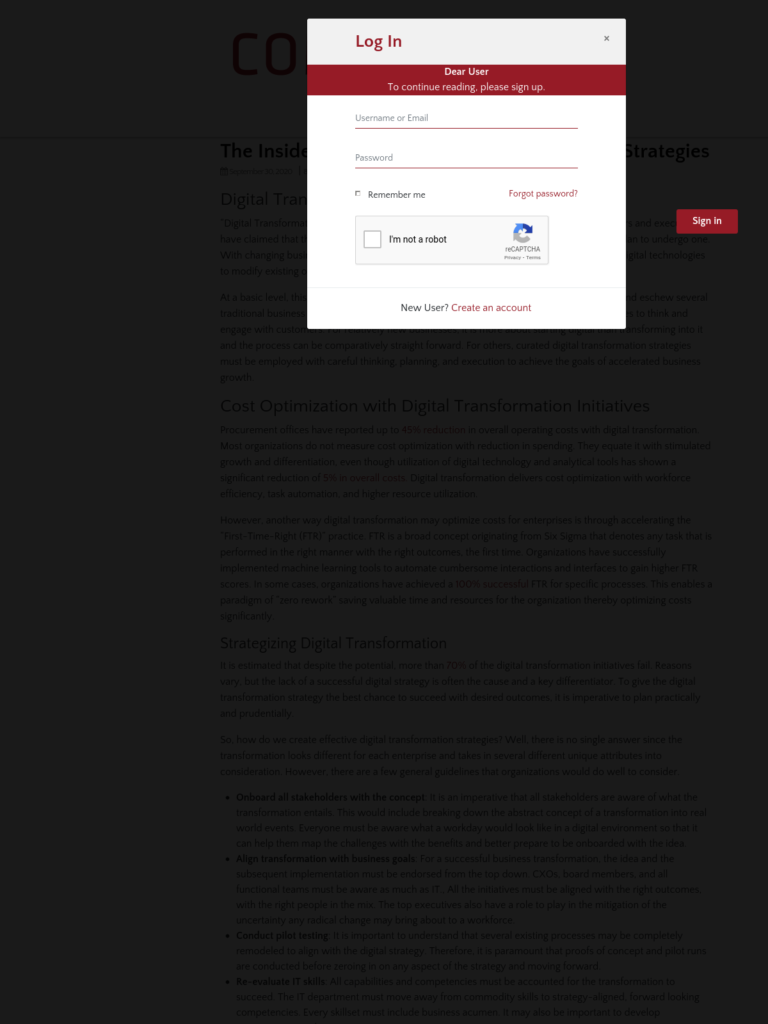The Inside-Out of the Digital-Transformation Strategies
Blog: NASSCOM Official Blog
Digital Transformation – why the buzz?
“Digital Transformation” has been a catchphrase for quite a while now. Many business leaders and executives have claimed that their businesses are either undergoing a radical digital transformation or plan to undergo one. With changing business requirements, most organizations adopt the strategy of employing digital technologies to modify existing or create new business practices to improve customer experience.
At a basic level, this intended transformation leverages digital technologies to remove silos and eschew several traditional business roles like customer servicing, sales, and marketing and remodels practices to think and engage with customers. For relatively new businesses, it is more about starting digital than transforming into it and the process can be comparatively straight forward. For others, curated digital transformation strategies must be employed with careful thinking, planning, and execution to achieve the goals of accelerated business growth.
Cost Optimization with Digital Transformation Initiatives
Procurement offices have reported up to 45% reduction in overall operating costs with digital transformation. Most organizations do not measure cost optimization with reduction in spending. They equate it with stimulated growth and differentiation, even though utilization of digital technology and analytical tools has shown a significant reduction of 5% in overall costs. Digital transformation delivers cost optimization with workforce efficiency, task automation, and higher resource utilization.
However, another way digital transformation may optimize costs for enterprises is through accelerating the “First-Time-Right (FTR)” practice. FTR is a broad concept originating from Six Sigma that denotes any task that is performed in the right manner with the right outcomes, the first time. Organizations have successfully implemented machine learning tools to automate cumbersome interactions and interfaces to gain higher FTR scores. In some cases, organizations have achieved a 100% successful FTR for specific processes. This enables a paradigm of “zero rework” saving valuable time and resources for the organization thereby optimizing costs significantly.
Strategizing Digital Transformation
It is estimated that despite the potential, more than 70% of the digital transformation initiatives fail. Reasons vary, but the lack of a successful digital strategy is often the cause and a key differentiator. To give the digital transformation strategy the best chance to succeed with desired outcomes, it is imperative to plan practically and prudentially.
So, how do we create effective digital transformation strategies? Well, there is no single answer since the transformation looks different for each enterprise and takes in several different unique attributes into consideration. However, there are a few general guidelines that organizations would do well to consider.
- Onboard all stakeholders with the concept: It is an imperative that all stakeholders are aware of what the transformation entails. This would include breaking down the abstract concept of a transformation into real world events. Everyone must be aware what a workday would look like in a digital environment so that it can help them map the challenges with the benefits and better prepare to be onboarded with the idea.
- Align transformation with business goals: For a successful business transformation, the idea and the subsequent implementation must be endorsed from the top down. CXOs, board members, and all functional teams must be aware as much as IT., All the initiatives must be aligned with the right outcomes, with the right people in the mix. The top executives also have a role to play in the mitigation of the uncertainty any radical change may bring about to a workforce.
- Conduct pilot testing: It is important to understand that several existing processes may be completely remodeled to align with the digital strategy. Therefore, it is paramount that proofs of concept and pilot runs are conducted before zeroing in on any aspect of the strategy and moving forward.
- Re-evaluate IT skills: All capabilities and competencies must be accounted for the transformation to succeed. The IT department must move away from commodity skills to strategy-aligned, forward looking competencies. Every skillset must include business acumen. It may also be important to develop competencies with L&D.
- Brace for a cultural transformation: At its heart, digital transformation is really a personal challenge. Accepting risks and aligning oneself with a comprehensive rehaul of doing things, are just some of the personal traits that can contribute to make digital transformation an organizational success story. In this regard, having the right people onboard can make or break the initiative.
A successful digital transformation brings about manifold benefits for the undertaking organization. The visible overarching benefits are enhancement of organizational transparency, collaboration, efficiency, higher utilization of resources, and better experience, engagement, and retention of customers. However, another crucial outcome is the cost optimization that is visible across the enterprise and all its functions.
In Conclusion
Today, the question with digital transformation is not if but when. The new normal has already shown us that digital will replace personal interactions to a great extent and it is only a matter of time before every enterprise joins the bandwagon. A well strategized and systematically executed digital transformation can bring about multitude benefits for a business. From growth to resilience and from driving innovation to success, fostering a secure tomorrow for an organization lies squarely on creating a pragmatic and effective digital transformation strategy, today.
The post The Inside-Out of the Digital-Transformation Strategies appeared first on NASSCOM Community |The Official Community of Indian IT Industry.
Leave a Comment
You must be logged in to post a comment.








